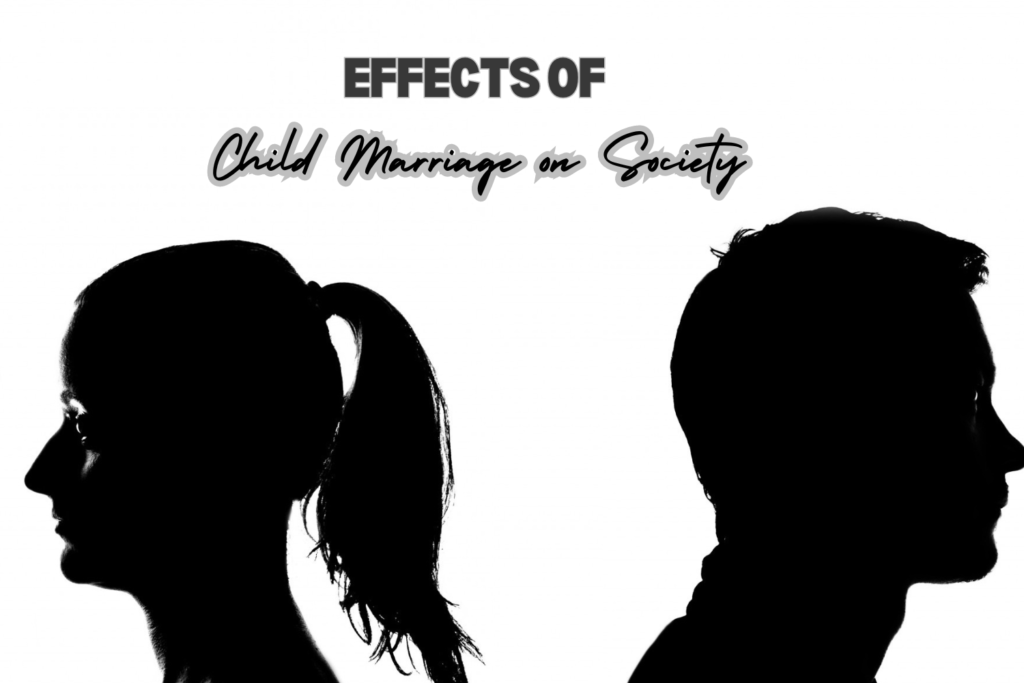Child marriage, defined as a formal marriage or informal union before the age of 18, remains a widespread issue with significant consequences for individuals and societies worldwide. Despite global efforts to combat this practice, millions of children, particularly girls, are married off each year. This blog post delves into the multifaceted impacts of child marriage on society, highlighting the profound implications for health, education, economic development, and gender equality.
Health Impacts
Child marriage has devastating health consequences, particularly for young girls who are often not physically or emotionally prepared for marriage and motherhood.
- Maternal and Infant Health: Girls who marry early are more likely to experience complications during pregnancy and childbirth. They face higher risks of obstetric fistulas, preterm birth, and maternal mortality. Infants born to young mothers also face increased risks of low birth weight, neonatal complications, and mortality.
- Sexual and Reproductive Health: Child brides are often unable to negotiate safe sex practices, leading to higher rates of sexually transmitted infections (STIs), including HIV. Limited access to sexual and reproductive health services exacerbates these risks, perpetuating cycles of poor health.
- Mental Health: The psychological impact of child marriage is profound. Young girls forced into marriage often experience depression, anxiety, and post-traumatic stress disorder (PTSD). The loss of childhood, social isolation, and the pressure to bear children can lead to long-term mental health issues.
Educational Consequences
Education is one of the most effective tools for empowering individuals and breaking the cycle of poverty. Child marriage, however, significantly disrupts educational opportunities for young girls.
- School Dropout Rates: Child marriage is a leading cause of school dropout among girls. Once married, girls are often expected to take on household responsibilities and caregiving roles, leaving little time for education. This truncation of education limits their future opportunities and economic prospects.
- Educational Attainment: The interruption of education due to early marriage means that girls are less likely to achieve higher levels of education. This lack of education restricts their ability to participate in skilled labor markets, perpetuating cycles of poverty and dependence.
- Generational Impact: The educational disadvantages faced by child brides extend to their children. Children of young, uneducated mothers are less likely to receive proper education and healthcare, continuing the cycle of disadvantage.
Economic Effects
The economic impact of child marriage is far-reaching, affecting not only the individuals involved but also broader society.
- Economic Productivity: Child marriage limits the economic potential of young girls. With disrupted education and limited opportunities for skill development, these girls are less likely to enter the workforce or engage in income-generating activities, reducing overall economic productivity.
- Poverty Perpetuation: Families often marry off their daughters due to financial constraints, hoping to reduce economic burdens. However, child marriage perpetuates poverty by curtailing educational and economic opportunities, creating a cycle of poverty that affects future generations.
- Healthcare Costs: The health complications associated with child marriage lead to increased healthcare costs for families and societies. Treating maternal and infant health issues, managing STIs, and addressing mental health concerns place significant financial strain on healthcare systems.
Gender Inequality
Child marriage is both a cause and consequence of gender inequality, reinforcing harmful gender norms and limiting the rights and freedoms of young girls.
- Violence and Abuse: Child brides are more likely to experience domestic violence, sexual abuse, and coercive control. The power imbalance in these marriages often leaves young girls vulnerable to exploitation and abuse.
- Lack of Autonomy: Child marriage strips girls of their autonomy and decision-making power. They are often denied the right to make choices about their education, career, health, and even the timing and number of their children.
- Gender Norms: The practice of child marriage reinforces patriarchal norms that view girls as commodities and undervalue their potential. This perpetuates cycles of discrimination and limits the progress towards gender equality.
Societal Consequences
The implications of child marriage extend beyond individuals and families, affecting broader societal development and progress.
- Population Growth: Child marriage contributes to higher fertility rates and rapid population growth. Young brides tend to have more children over their lifetime, which can strain resources and hinder sustainable development efforts.
- Human Rights Violation: Child marriage is a violation of human rights, denying young girls the right to health, education, and freedom from violence. Societies that tolerate child marriage fail to uphold fundamental human rights and gender equality.
- Social Development: The practice of child marriage hinders social development by limiting the potential contributions of half the population. When girls are educated and empowered, they can contribute significantly to social, economic, and political progress.
Conclusion:
The effects of child marriage on society are profound and far-reaching. It undermines health, education, economic development, and gender equality, perpetuating cycles of poverty and inequality. Addressing child marriage requires a multi-faceted approach, including legal reforms, education initiatives, economic support for families, and efforts to change cultural norms. By working together, we can create a world where every child has the opportunity to thrive, free from the constraints of early marriage.
For a more detailed analysis and comprehensive data on the effects of child marriage, download the full PDF report “Effects of Child Marriage on Society: A Comprehensive Analysis” from the Elmbrook Humane Society’s website. This report offers valuable insights and actionable recommendations for policymakers, educators, and advocates working to end child marriage and promote gender equality.
FAQs:
1. What is child marriage, and why is it a significant issue?
Child marriage refers to any formal or informal union where one or both parties are under the age of 18. It is a significant issue because it has profound consequences on the health, education, and economic opportunities of young individuals, particularly girls. It perpetuates cycles of poverty, limits personal development, and reinforces gender inequality, impacting both individuals and society as a whole.
2. How does child marriage affect the health of young girls?
Child marriage has severe health impacts on young girls, including increased risks of maternal and infant mortality, complications during pregnancy and childbirth, and higher rates of sexually transmitted infections (STIs). Young brides are also more likely to experience mental health issues such as depression and anxiety due to the psychological strain and loss of childhood.
3. What are the educational consequences of child marriage?
Child marriage often leads to school dropout, as young girls are required to take on household responsibilities and caregiving roles. This disruption in education limits their future opportunities and economic prospects. The lack of education also has generational effects, as children of child brides are less likely to receive proper education and healthcare, continuing the cycle of disadvantage.

